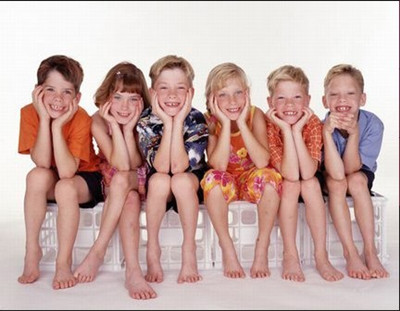多胞胎
Oh, baby
噢,宝贝
A reduction in multiple-birth pregnancies is a good thing
多胞胎怀孕率的减少是件好事
IT HAS long been known that in-vitro fertilisation (IVF) increases the chances of multiple births, as several fertilised eggs are implanted in a woman to improve the chances of pregnancy. A fifth of all successful IVF treatments in Britain result in multiple-birth pregnancies, compared with just over 1% from natural conceptions.
众所周知体外受精(IVF)可以增加多胞胎几率,因为要将几个受精卵植入一个女人体内来提高受孕几率。在英国,自然分娩多胞胎的几率仅超过1%,而体外受精的方式则成功的将多胎妊娠的几率提升到1/5。

Such was the success of IVF after the first test-tube baby was born in 1978 that the rate of all multiple-birth pregnancies rose from ten per 1,000 in that year to 16.4 in 2009. The total number of multiple births doubled during that time. However, for women over 35—frequently users of IVF—it shot up 600%.
自1978年第一例试管婴儿出生之后,多胞胎受孕率由那一年的千分之十上升到2009年的千分之16.4,这是体外受精的又一成功。多胞胎的总数在那些年间翻了一倍。但是,对于35岁以上的妇女,即体外受精的常见对象,她们生产的多胞胎总数直线上升了600%。
When all goes well, a multiple birth can be good news for women who had difficulty conceiving. But it also carries risks: the infant mortality rate is five times higher than for single births. So the fact that newly released statistics show that the number of multiple births has started to fall is welcome.
当一切都顺利的时候,多胞胎对于经历了痛苦艰难治疗的不孕妇女来说无疑是个好消息。但这也同样带来危险:多胞胎的婴儿死亡率比一个婴儿高五倍。最新发布的统计数据显示多胞胎的数量正开始降低,这也算是个好消息。
This is largely a result of a new policy adopted by the Human Fertilisation and Embryology Authority (HFEA), a regulator. In 2009 it launched the elective single-embryo transfer policy (now part of its multiple-births minimisation strategy) with the aim of reducing overall IVF multiple pregnancies from 27% in 2008 to 20% initially. HFEA’s latest figures, dating from 2012, show that the rate has slowed to 18%. The current target is 10%. According to the HFEA, multiple-birth pregnancies carry a higher risk of premature delivery and children having disabilities as well as late miscarriage, high blood pressure and pre-eclampsia for expectant mothers. At least that risk is now being tackled for IVF users.
这主要是监管机构人类受精与胚胎管理局(HFEA)执行新政策的结果。2009年它推出了选择性单个胚胎转移政策(如今是多胞胎简化策略的一部分),目的是要将体外受精多胞胎的的总比率由2008年的27%降到最初的20%。HFEA的最新数据显示,从2012年起,多胞胎比率已经降到了18%。目前的目标是10%。根据HFEA的研究得出,多胞胎怀孕有早产、儿童残疾的较高风险,并且孕妇有晚期流产、高血压和先兆子痫的风险。至少现如今IVF受孕对象已经不会被这些风险所困扰了。翻译:邵夏沁 校对:胡雅琳













